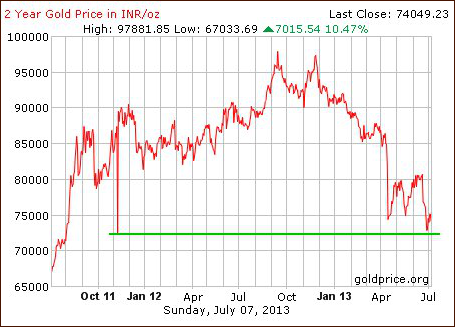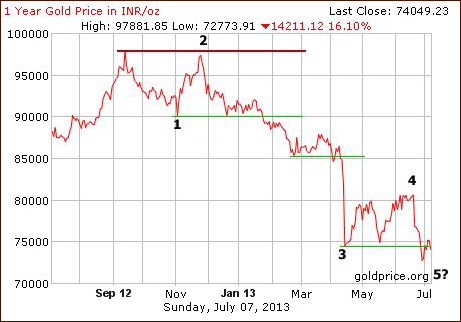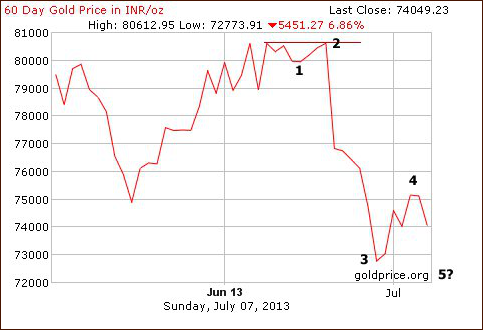Without a doubt, in the East gold is held in much higher esteem than in Europe or Americas. For Asians it is often a symbol of happiness, wealth, and all sorts of success. In India, the role of the yellow metal is even greater. The people of India love gold and for them it is more than a symbol of wealth and social status - it is a part of a cultural tradition that goes back thousands of years.
According to CBS News, from birth to death, for men and women, among rich and poor - acquiring gold is a goal for the people of India. All of which has made India the world's largest consumer of gold, and thus a powerhouse in the gold market. "If India sneezes, the gold industry will catch a cold," says Ajay Mitra of the World Gold Council.
Just as part of the American dream is to own a home, the dream in India is to own gold. For Indians, gold jewelry is wearable wealth, financial security that's also a fashion statement.
Should the recent collapse in gold price discourage consumers from India? Has the sentiment already turned bearish after gold fell in the global markets? We are not surprised you would want something to decline in price to buy more for yourself, but are you sure that the recent gold price collapse is as great a buying opportunity as it seems?
Let's take a look at the charts and search for some answers (charts courtesy by http://goldprice.org).

When we look at the long-term chart we see that gold's price declined from the September 2012 high at Rs 97,881.85 to below Rs 75,000 in June 2013.
Let's analyze this downward trend step by step.
The first bearish accent was an unsuccessful attempt to break above the September 2012 high. The lack of buying strength resulted in a decline in the price of gold. Another factor contributing to further devaluation was the breakdown below the support zone. This event encouraged gold bears to go short and triggered a deeper correction. The following months brought a further decline which paused for a short time in February 2013. Unfortunately, the buyer's power was too small to decelerate further declines in the yellow metal. The breakdown below the February 2013 bottom resulted in acceleration of the declines which had its peak in April 2013. The strong sell-off pushed gold to around Rs 75,000.
When you take a look at the above chart once again, you will see a green bold line which is a support level based on the November 2011 bottom. This area encouraged buyers to act and resulted in a bigger pullback. The price of gold climbed up to over Rs 80,000 per ounce.
Despite this positive event, the global market sentiment was still bearish and the rising U.S. dollar's strength was a strong blow to the whole precious metals sector. These negative circumstances resulted in further declines. The sell-off in precious metals pushed gold to lower levels and in June it hit new 2013 lows.
As you can see in the above chart, the price of gold dropped to just above the previously mentioned support level almost two weeks ago. This price level was not quite reached, but we are very close to it, and it seems that prices will decline once again. Although it is not good news, in the recent days this support level has triggered positive emotions among the gold bulls. Unfortunately, the pullback that we have been seeing is still quite small.
Now, let's take a closer look at the chart below which, in my opinion, shows quite clearly that gold hasn't found the bottom yet, as it seems. Let take a look from the perspective of the Elliott wave principle.

Let me explain as simply as possible the Elliott wave theory. It was developed by R.N. Elliot and popularized by Robert Prechter. Its major principle contends that markets move in 5 impulse waves in the direction of the main trend, and in 3 corrective waves as a counter trend. So, from this point of view, a large five-wave structure may not have been completed yet.
You can see it more clearly on the 60-day chart.

Therefore, from this perspective, the situation remains bearish for the short term and it doesn't look as optimistic as from the support/resistance perspective alone.
What is the investment scenario? Let's summarize.
Gold pulled back last week but the move to the upside did not invalidate the most important resistance levels. From my point of view, the outlook and trend remain bearish for the short term. In the immediate future, we could see some strength, but from the Elliott wave perspective the next big move will likely be to the downside.
If you'd like to stay up-to-date with our analysis of the gold market (including the commentaries on gold price in rupee terms) please sign up for our gold newsletter.
Thank you.
Nadia Simmons
Back
